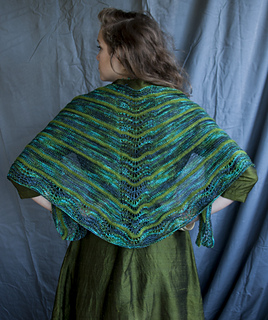patterns >  Alchemy: Yarns of Transformation
Alchemy: Yarns of Transformation
> Bon Vivant Shibori Shawl





Bon Vivant Shibori Shawl
Knit your inner Bon Vivant!!
Our simple triangular shawl demonstrates the elegant Shibori effect of using two exquisite yarns in one unique design. After the Bon Vivant is knit, it is lightly felted in a washing machine. The Silken Straw yarn (pure silk) does not felt, while the Sanctuary fiber (a dk wool/silk blend) does felt. To increase the dramatic effect of this pleasing combination of textures, a simple feather & fan lace stitch is miter centered in the design, and culminates in a beautiful undulating border at the bottom of this extraordinary trans-seasonal shawl ~ made in just (3) skeins of yarn. Joie de vivre!!!
A Word about the Special Technique of Shibori Knitting
While the Japanese word “shibori” cannot be directly translated into English, it basically denotes a “shape resist textile.” Most people are familiar with the concept of Tie Dye (originally called “tie and dye”), which is the most popular understanding of shibori. Ties such as rubber bands or strings are secured on a piece of fabric, and then that fabric is dyed; the fabric resists the dye where it has been bound.
Gina Wilde’s shibori design is an exploration of manipulating knit fabric, harnessing the effects of working differing types of yarns together (combing felting and non-felting fibers in one knit piece). In this wrap, the pure silk fiber (A) acts as a resist to the wool/silk felting fiber (B). When felted in a washing machine, the pure silk yarn actually grows in the process, while the wool/silk blend shrinks and felts. The result produces a textured and dramatic knit fabric, one that is light and airy, rather than the heavy dense fabric achieved when using traditional felting methods and yarns.
1919 projects
stashed
2435 times
809 projects
stashed
840 times
- First published: April 2015
- Page created: April 2, 2015
- Last updated: April 2, 2015 …
- visits in the last 24 hours
- visitors right now




